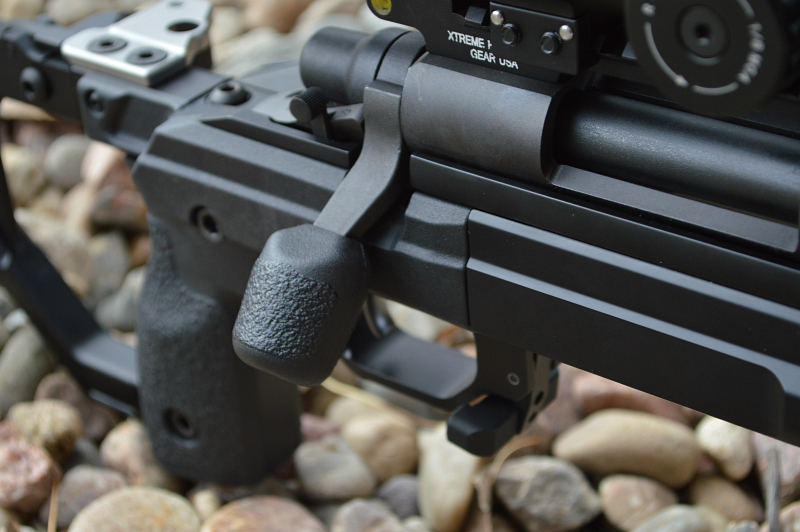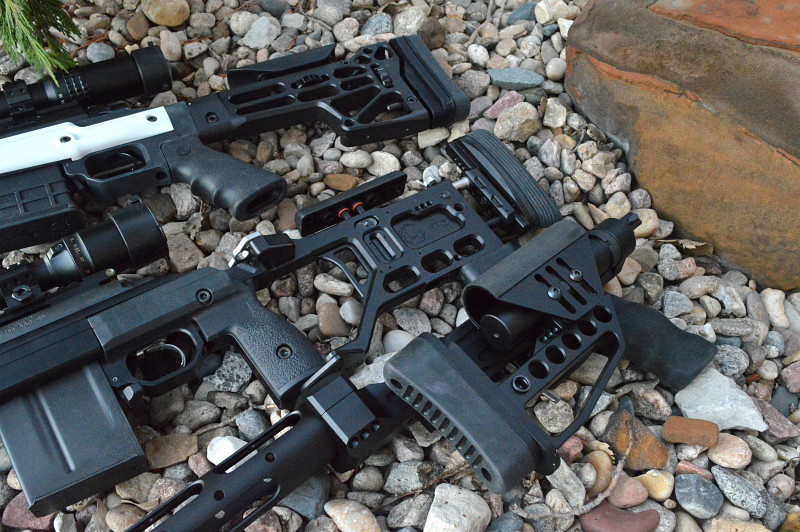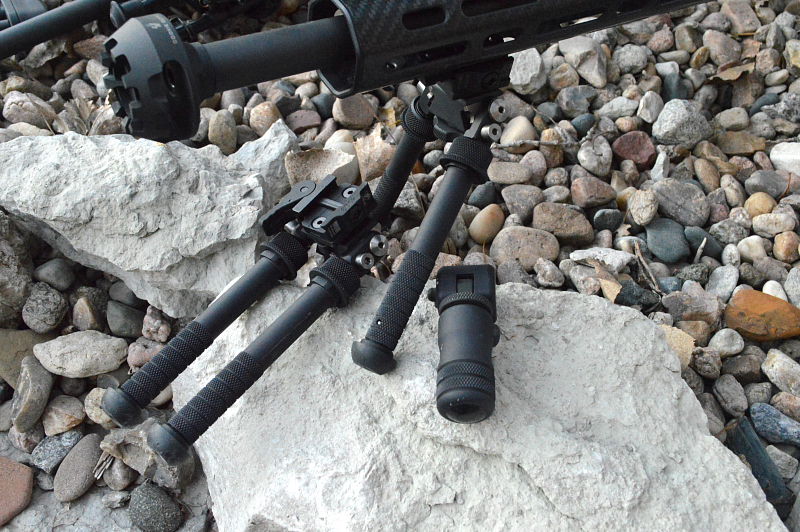Everything in the firearms industry has a season. Over the last decade there is no doubt that polymer handguns, AR-15s, Sig-Braced AR-15 pistols and AR308 firearms have all had their time in the high-volume sales spotlight. Currently, precision-bolt actions have become the next big thing customers want. Most shooter’s precision-bolt action rifle kits typically start as a Remington 700 SPS .308 or a similar rifle from Mossberg, Howa, Savage or Weatherby. Better factory triggers and stocks have improved out-of-the-box accuracy of these rifles, but customers are wanting more upgrades to improve accuracy. Beyond an upgrade to a match trigger, the most popular upgrade for precision rifle work is a bolt-on billet chassis.
A More Accurate Choice
Top-end precision stocks are one of the most expensive DIY bolt-on upgrades, so customers will ask why they should go through the trouble and expense to move from a factory stock to a billet aluminum chassis system. There are a number of reasons to upgrade to a billet stock, but the most significant reason is up to a 20 percent accuracy improvement. The additional benefits to customers are a simple DIY beddingless install, magazine feeding and increased shooter comfort.
Accuracy Improvement - Consistency and improved accuracy improvements are impressive due to a billet chassis platform, which is unaffected by weather and humidity from shot to shot. The accuracy improvements are due to a mechanical bedding system and a free-float barrel chassis design. Although not empirical evidence, each Remington 700 and Howa 1500 chassis I have tested has shown to deliver around a 15- to 20-percent accuracy improvement over the factory Hogue stocks. For example, this reduced my best 100-yard .65-inch-ish groups down to just over 1/2-inch and my more typical .8- inch- to .9- inch groups down to the .7- inch- to .75-inch mark. Not transformational, but it is a noticeable improvement and delivers more consistent groups, which could make a huge difference at 800 to 1,000 yards. A consistent, sub-MOA, 100-yard grouping rifle could become a consistent half-MOA rifle with a trigger and chassis upgrade.
Easy Beddingless Installation - Until the billet aluminum chassis design, most precision shooters felt the only way to attain the ultimate accuracy potential of a new precision stock was to glass/resin bed the stock — a process that is inherently messy and easy to screw up. Conversely, the aluminum chassis designs deliver optimal accuracy with what many term a type of pillar bedding, which mechanically locks up the action to the rigid structure of the chassis with repeatability — thus providing the same benefits of glass bedding without the mess and problems. All that’s required of the shooter is to remove the two screws from the action and then reattach the action to the new billet chassis with two bolts, preferably to a specified torque setting. Delivering all the benefits of a billet chassis to your bolt action could not be simpler or faster.
Magazine-Fed Conversion - Most of the aftermarket chassis also deliver integrated AICS-style box magazine compatibility, which saves you around $200 for a “bottom metal” AICS-compatible magazine adapter for your factory stock. Instead of a three- or four-round floor plate-style magazine, you can feed your precision beast with magazines of 10 rounds at a time. Magazine compatibility allows customers to quickly reload or conveniently unload the rifle without dumping rounds on the ground. It should be noted to customers that some chassis do require the magazines to be modified for proper operation, just as that is required on occasion with other stocks that provide a magazine conversion.
Comfort - These chassis are ergonomically and stability optimized for prone or benchrest shooting positions, which deliver long-term shooting comfort behind the gun over long periods of lying or sitting down. Most customers find there is a world of difference in comfort and fit when they lay down behind one of these chassis.
How They Fit
Now that your customer is sold on a new chasses for their rifle, it’s important to remember a few things about how chassis systems work before they plunk down their hard-earned cash to trick out their bolt gun.
Adjustability and Customization - Most of these billet chassis deliver a huge breadth of adjustability and customization to the shooter’s needs, including full adjustability for cant, cheek rest position, cheek rest height, length of pull and buttpad height. You can get insanely comfy behind any of these rifle chassis. Most buttstocks are angled to work with sandbags for elevation adjustments when prone or on the bench. More comfort equals longer, more comfortable shooting, less shooter fatigue and more than likely better groups in the process.
Types of Billet Chassis Options - There are two main types of precision billet chassis designs available — those that come complete with a buttstock and those that require the user to add their favorite AR-compatible buttstock. The KRG Whiskey 3 as an example, features an integrated, non-folding or folding buttstock with all the adjustability a user could ever want. The MDT and XLR chassis are compatible with AR buffer-tube-style stocks. The inexpensive MDT Tac LSS and HS3 MDT require the user to add their own preferred AR buttstock assembly. Alternatively, XLR’s chassis options are all compatible with AR-style stocks, but are sold with their own highly adjustable buttstock assemblies, which are notably more comfortable and adjustable than any other AR stock I have used.
Weight - Most precision chassis are pretty heavy, and the billet versions are no exception in the 3- to 5-pound range. A packable rubber Hogue-stocked Remington 700 can quickly become unbearably heavy with 3 extra pounds of weight. The purpose-built precision billet chassis are designed to be supported with a bipod or sandbags and deliver weight and stability to increase long-range precision. If a customer wants the accuracy advantages of a billet chassis with a trimmer and lighter weight option to carry for miles, recommend the very lightweight 1.7-pound MDT Tac LSS or 2.5-pound HS3 chassis.
Price Range - The prices of the billet chassis vary widely from $399 to $1,300, depending on features and details of the stock. The base benefits of the billet chassis systems are present at all price ranges. Each chassis has its own benefits and weaknesses buyers need to consider before purchase.
What We Found
There are hundreds of billet chassis options for bolt actions and we simply could not get our hands on every option. We did gather a good representation of the various chassis styles noted as the most popular consumer upgradable options, which all have completely different designs from XLR Industries, KRG and MDT Tac.
XLR Industries - XLR’s modern designs deliver a level of clean refinement to any build while reducing weight and still delivering all the features required of professional shooters. XLR’s designs were created based on computer modeling to increase shooter comfort and reduce recoil and shooter fatigue. My experience is that the superb ergonomics deliver the most comfortable chassis designs I have tested. XLR offers a CARBON model with a carbon fiber handguard and a similar EVOLUTION chassis with a billet enclosed forend and a typical open ELEMENT model as well. Models range from $595-$985, with support for Remington, Howa, Sako, Tikka and Savage plus approximately 40 additional inlet options. XLR also offers support for up to the big .50 BMG actions.
KRG - The feature-rich, highly adjustable and extremely comfortable $1,300 KRG Whiskey 3 with folding stock has become one of the most recognized and oldest precision billet chassis designs. Today, the company offers a variety of similar models based on the company’s original Whiskey 3 design with inlet options for Remington short and long action, Howa, Savage, Tikka and even a .22LR CZ-455 model. Models range from $599-$1,300, depending on options.
MDT Tac - This company is based out of Canada, but they do ship internationally and offer three unique AR-15-buttstock, assembly-compatible billet chassis options. MDT Tac’s LSS is the lightest billet chassis on the market, the 2.5-pound HS3 is available with five different polymer colors to fit various hunting environments without repainting the chassis, and the TAC21 is a heavy sniper-style chassis to optimize accuracy. The company offers inlets for Remington short and long actions, Howa, Savage and Tikka models, which range from $399 to $690. All models do require an additional AR-compatible buttstock assembly of the shooter’s choice, but do offer an optional, adjustable skeletonized chassis.
Inlet Options - Although the vast majority of billet chassis are designed for the Remington 700 Short Action inlet, many chassis manufacturers offer other inlets for Remington models, Savage, Mossberg, Tikka T3, Sako, FN short action, Armalite AR50, Howa 1500 and Weatherby Vanguard rifles. In addition, almost everyone supports the wide range of custom precision Remington-style actions such as those from Defiance, Stiller and Big Horn. XLR Industries offers the widest inlet options of any precision chassis manufacturer.
Magazine Options and Compatibility - Accuracy International AICS-compatible format magazines are the most widely popular magazine option for precision billet chassis. AICS makes various capacity magazines, but ALPHA, Magpul, Ruger and MDT Tac all offer great options as well. The ALPHA are my favorite simply because the design is compact, shorter and double-stacked with a strong design. Magpul and MDT now offer shorter double-stack designs as well in polymer that are lighter and cost less. The $39.99 MDT Tac magazines also work with the flat-bottom Howa 1500 actions.
Easy Upgrade - Among the many different bolt actions XLR offers billet chassis for, the Remington 700 short and long action are by far the most popular. Shooters get a drop-in stock replacement, which delivers everything the professional and amateur shooter could ever want in a precision stock.
Trigger Upgrade Options - Upgrading the factory trigger on any rifle to a lighter, crisper match trigger can shrink groups anywhere from 5 to 40 percent, depending on the rifle and the trigger. Many customers are so happy with the results of this drop in DIY $100-$250 upgrade that they hesitate to make the higher-cost upgrade to a new stock. There are a significant number of aftermarket trigger options for the Remington 700 platform from Timeny, Shilen, Jewell, Jard and more. The list of aftermarket match triggers shrinks with Savage, Howa and Weatherby actions to just a couple offerings. Timney Triggers offers the broadest array of trigger options for more than 20 brands. Customers dropping the money on a billet chassis should be encouraged to upgrade to a match trigger at the same time. Our featured Howa 1500 and Remington 700 actions were both upgraded to Timney match, 2-pound triggers, which delivered superb trigger feels in less than a five-minute upgrade.
Bipod and Monopod Options - Bipods are critical when it comes to delivering a solid shooting platform. Beyond the $30 bipod a customer picks just to have something to shoot from, customers should be encouraged to consider a more advanced bipod with full pan, tilt and positionable legs. Among bipods, the Accu-Shot Atlas Bipod is considered the finest bipod made and delivers all of the above noted pan, tilt and leg position adjustability. All the adjustments can be made quickly with one hand, and the pan and tilt tension can also be adjusted to fit the needs of the shooter. At $280 to $380, the heirloom-quality Atlas bipods are expensive, but the first time a customer shoots with one, they will never want anything else on their precision rifle. Accu-Shot also manufactures matching quality adjustable monopods for the rear of the stock to negate the need for sandbags.
Must-Have Accessories - KRG also manufactures the KRG Bolt Lift must-have accessory for every Remington 700 build, which provides the shooter all the benefits of an oversized bolt-charging handle in a DIY bolt-on $29 option. Most long-range shooters extending out to 1,000 yards recommend a 20 MOA base to allow for extended, optic elevation adjustment.









